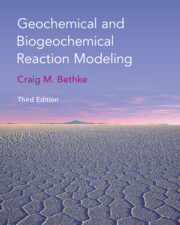Book contents
- Frontmatter
- Dedication
- Contents
- Preface
- Preface to Second Edition
- Preface to First Edition
- A Note About Software
- 1 Introduction
- 2 Modeling Overview
- PART I EQUILIBRIUM IN NATURAL WATERS
- 3 The Equilibrium State
- 4 Solving for the Equilibrium State
- 5 Changing the Basis
- 6 Equilibrium Models of NaturalWaters
- 7 Redox Disequilibrium
- 8 Activity Coefficients
- 9 Sorption and Ion Exchange
- 10 Surface Complexation
- 11 Three-Layer Complexation
- 12 Automatic Reaction Balancing
- 13 Uniqueness
- PART II REACTION PROCESSES
- PART III APPLIED REACTION MODELING
- Appendix A Sources of Modeling Software
- Appendix B Evaluating the HMW Activity Model
- Appendix C Minerals in the LLNL Database
- Appendix D Nonlinear Rate Laws
- References
- Index
4 - Solving for the Equilibrium State
from PART I - EQUILIBRIUM IN NATURAL WATERS
Published online by Cambridge University Press: 09 December 2021
- Frontmatter
- Dedication
- Contents
- Preface
- Preface to Second Edition
- Preface to First Edition
- A Note About Software
- 1 Introduction
- 2 Modeling Overview
- PART I EQUILIBRIUM IN NATURAL WATERS
- 3 The Equilibrium State
- 4 Solving for the Equilibrium State
- 5 Changing the Basis
- 6 Equilibrium Models of NaturalWaters
- 7 Redox Disequilibrium
- 8 Activity Coefficients
- 9 Sorption and Ion Exchange
- 10 Surface Complexation
- 11 Three-Layer Complexation
- 12 Automatic Reaction Balancing
- 13 Uniqueness
- PART II REACTION PROCESSES
- PART III APPLIED REACTION MODELING
- Appendix A Sources of Modeling Software
- Appendix B Evaluating the HMW Activity Model
- Appendix C Minerals in the LLNL Database
- Appendix D Nonlinear Rate Laws
- References
- Index
Summary
The equilibrium state of a chemical system composed of an arbitrary number of thermodynamic components is described by a set of nonlinear equations that can be evaluated only using iterative methods. This chapter provides a detailed description of the process by which the Newton–Raphson method can be applied to solve for the equilibrium distribution of chemical mass in a multicomponent system composed of aqueous, solid, and gaseous phases.
Keywords
- Type
- Chapter
- Information
- Geochemical and Biogeochemical Reaction Modeling , pp. 45 - 58Publisher: Cambridge University PressPrint publication year: 2022

